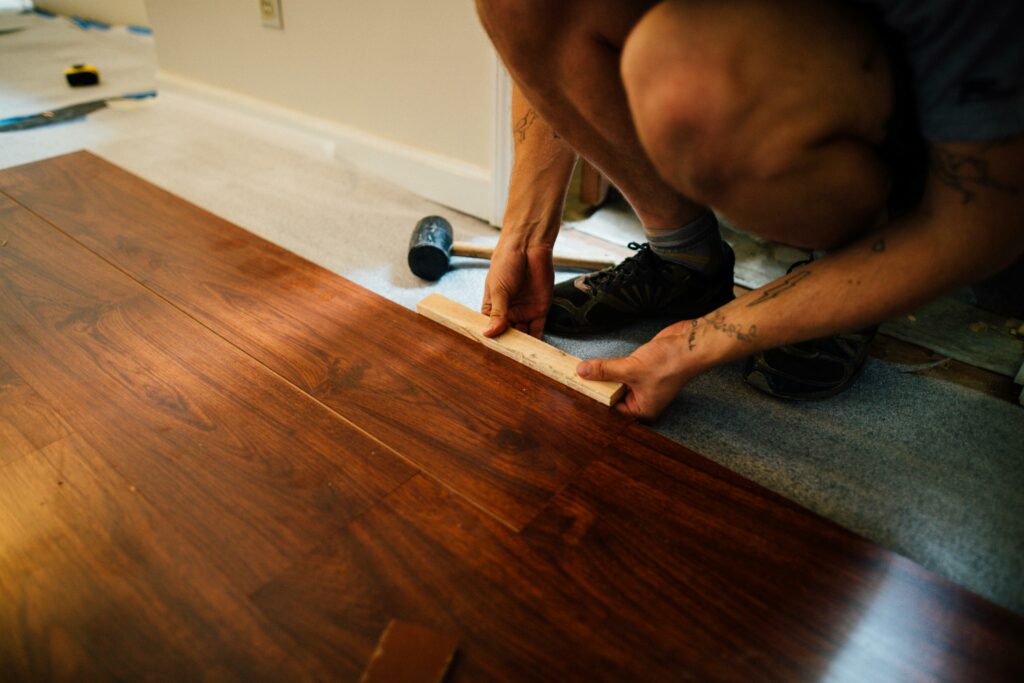Laminate and vinyl flooring are two of the most popular and reasonably priced options available today for kitchen flooring renovation. Due to their distinct benefits, laminate and vinyl are both excellent choices for kitchen spaces. However, before choosing, you should also take note of their disadvantages.
That is why we’ll make a comparison here with both their advantages and disadvantages based on our experience here at Askin Cabinets. So read on to know all about it and make your decision on which to use if you’re planning on doing a floor renovation in your kitchen!

Laminate
A multi-layered synthetic material, laminate flooring imitates the appearance of genuine stone, hardwood, or tile. It has a clear protective covering on top of a photographic appliqué layer that gives the ideal wood or stone look and an interior core composed of high-density fiberboard or plastic laminate.
Advantages of Kitchen Laminate Flooring:
- Aesthetics: For a fraction of the price of real materials like hardwood, slate, or ceramic tile, laminate flooring may beautifully replicate their rich hues and textures.
- Simple Installation: The tongue-and-groove or click-lock mechanism of laminate boards makes installation quick and simple, frequently requiring no adhesives.
- Cost-Effective: Laminate flooring is a great option for homes on a tight budget because it is far less expensive than hardwood, stone, or ceramic tile flooring.
- Durability: High-quality laminate floors are ideal for busy kitchens because they can withstand heavy foot traffic, dents, and scratches.
- Low Maintenance: Just routine sweeping and the occasional damp mopping are needed to keep laminate flooring clean and in good condition.
Disadvantages of Kitchen Laminate Flooring:
- Not Waterproof: Laminate flooring can swell or sustain damage over time if exposed to heavy moisture or standing water, even though they are water-resistant.
- Limited Lifespan: The majority of laminate floors require replacement after 15 to 25 years of use.
- Difficult to Repair: It might be difficult to replace or repair a broken part of a laminate board without leaving a noticeable seam or transition.
- Possibility of Peaking and Gaps: If laminate flooring is put incorrectly or if the subfloor is uneven, it may “peak” or split at the seams.
Vinyl
Vinyl flooring is a synthetic material composed of polyvinyl chloride (PVC) and other components. It is often referred to as resilient flooring. It can resemble stone, tile, or wood and is available in sheets, tiles, or planks.
Advantages of Kitchen Vinyl Flooring:
- Waterproof: Vinyl flooring is waterproof, unlike laminate, which makes it a great option for kitchens where spills and moisture are common.
- Durability: High-grade vinyl flooring has an exceptional resistance to dents, scratches, and stains, meaning that it will last for a long time in high-traffic areas like kitchens.
- Comfort Underfoot: For long hours of standing, vinyl floors can be more pleasant than laminate because of their softer, more cushioned feel.
- Numerous Design Options: Vinyl flooring is available in a wide range of hues, patterns, and styles, so you may design your kitchen to almost any aesthetic you like.
Disadvantages of Kitchen Vinyl Flooring:
- Possibility of Discoloration: Vinyl floors have the potential to discolor or yellow over time, particularly in locations that receive direct sunshine.
- Limited Lifespan: While vinyl of superior quality might endure for 20 years or longer, vinyl of lesser quality may need to be replaced sooner, usually within 10 to 15 years.
- Seam Visibility: When using vinyl sheets or tiles, seams may eventually show through and potentially take away from the overall design.
- Off-Gassing: Although many manufacturers now offer low-VOC or VOC-free choices, some vinyl flooring types can emit volatile organic compounds (VOCs) that contribute to indoor air pollution.
- Possibility of Indentation: Particularly in high-traffic areas like kitchens, heavy furniture or appliances can leave permanent dents in vinyl floors.
Making Your Choice
Take into account the following aspects to help you in choosing the finest choice for your kitchen:
- Moisture Levels: Vinyl flooring can be a better option because it is waterproof if your kitchen is prone to high moisture levels or frequent spills.
- Budget: For people on a restricted budget, laminate flooring is a cost-effective solution because it is typically less expensive than premium vinyl.
- Design Preferences: There are many design options available with both laminate and vinyl, so think about which material best fits the aesthetic you’ve in mind for your kitchen.
- Installation Method: Depending on the type and your degree of expertise, installing laminate floors is a simpler DIY task than installing vinyl flooring, which may need professional installation.
Made Your Choice? Contact Askin Cabinets!
We at Askin Cabinets are aware of how stressful renovating a kitchen can be. Our design experts can guide you through the many flooring selections while taking your lifestyle, budget, and aesthetic tastes into consideration. Not only will we assist you in selecting the ideal flooring to go with your new cabinets, but we’ll also make sure the installation goes smoothly.
Together, let’s design the kitchen of your dreams! For a quote, get in touch with Askin Cabinets right now!
